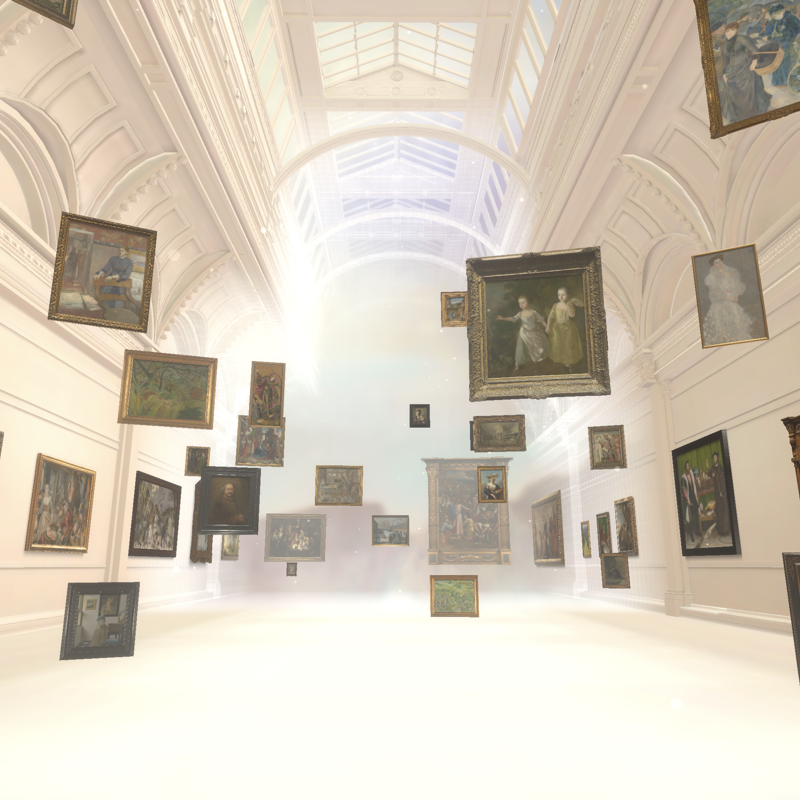Gustav Klimt, 'Portrait of Hermine Gallia', 1904
About the work
Overview
This is the only painting by Klimt in a British public collection, and it’s a fine example of the portraits of society women he painted in the early years of the twentieth century. Wearing a shimmering dress made of translucent white chiffon, Hermine Gallia appears almost to float before us. The sinuous lines of her dress recall Art Nouveau and Japanese prints. The geometrical pattern of its lower half, and the mosaic-like design of the carpet, hint at the ‘Byzantine’ style Klimt was to adopt a few years later.
Klimt was the leading artist in Austria at the time. He was a founder member and the first president of the Vienna Secession, an association established in 1897 to promote modernism in art, design and architecture. Hermine Gallia and her husband were also important patrons of the avant garde.
Key facts
Details
- Full title
- Portrait of Hermine Gallia
- Artist
- Gustav Klimt
- Artist dates
- 1862 - 1918
- Date made
- 1904
- Medium and support
- oil on canvas
- Dimensions
- 170.5 × 96.5 cm
- Inscription summary
- Signed; Dated
- Acquisition credit
- Bought, 1976
- Inventory number
- NG6434
- Location
- Room 11
- Collection
- Main Collection
- Frame
- 20th-century Replica Frame
Exhibition history
-
2009Long Loan to Tate (2009 - 2019) (Tate Exchange Loans)Tate Gallery (London)25 March 2009 - 24 March 2019
-
2011Vienna, Art and Design: Klimt, Schiele, Hoffmann, LoosNational Gallery of Victoria18 June 2011 - 9 October 2011
-
2011Klimt/Hoffmann: Pioneers of ModernismÖsterreichische Galerie Belvedere25 October 2011 - 4 March 2012Museo Correr23 March 2012 - 8 July 2012
-
2013Facing the Modern: The Portrait in Vienna 1900The National Gallery (London)9 October 2013 - 12 January 2014
-
2015The Women of Klimt, Schiele and KokoschkaÖsterreichische Galerie Belvedere22 October 2015 - 28 February 2016
-
2021Hodler, Klimt and the Wiener WerkstätteKunsthaus Zürich21 May 2021 - 29 August 2021
-
2022Whistler’s Woman in White: Joanna HiffernanRoyal Academy of Arts23 February 2022 - 22 May 2022
-
2022Golden Boy Gustav KlimtVan Gogh Museum7 October 2022 - 8 January 2023
-
2023After Impressionism: Inventing Modern ArtThe National Gallery (London)25 March 2023 - 13 August 2023
Bibliography
-
1971Christie's, Fine Gold Boxes and Works of Art, London, 30 November 1971
-
1978The National Gallery, The National Gallery: July 1975 - December 1977, London 1978
-
1983P. Vergo et al., Vienna 1900: Vienna, Scotland and the European Avant-Garde (exh. cat. National Museum of Antiquities of Scotland, 10 August - 25 September 1983), Edinburgh 1983
-
1984T. Lane et al., Vienna 1913: Josef Hoffman's Gallia Apartment (exh. cat. National Gallery of Victoria, 11 April - 10 June 1984), Melbourne 1984
-
1986E.H. Gombrich, Kokoschka in His Time, London 1986
-
1986M. Levey, Director's Choice: Selected Acquisitions 1973-1986: An Exhibition to mark the Retirement of Sir Michael Levey as Director of the National Gallery (exh. cat. The National Gallery, 17 December 1986 - 15 February 1987), London 1986
-
1989G. Fliedl, Gustav Klimt 1862-1918: Die Welt in weiblicher Gestalt, Cologne 1989
-
1989F. Huici, Klimt, New York 1989
-
1992T. Stooss and C. Doswald (eds), Gustav Klimt (exh. cat. Kunsthaus, 11 September - 13 December 1992), Stuttgart 1992
-
1994C.M. Nebehay, Gustav Klimt: From Drawing to Painting, London 1994
-
2000T.G. Natter (ed.), Klimt und die Frauen (exh. cat. Galerie Belvedere, September 20 2000 - 7 January 2001), Vienna 2000
-
2001
C. Baker and T. Henry, The National Gallery: Complete Illustrated Catalogue, London 2001
-
2001C.B. Bailey, Gustav Klimt: Modernism in the Making (exh. cat. National Gallery of Canada, 14 June 2001 - 16 September 2001), New York 2001
-
2005H. Prigent (ed.), Vienne 1900: Klimt, Schiele, Moser, Kokoschka (exh. cat. Galeries Nationales du Grand Palais, 3 October 2005 - 23 January 2006), Paris 2005
About this record
If you know more about this painting or have spotted an error, please contact us. Please note that exhibition histories are listed from 2009 onwards. Bibliographies may not be complete; more comprehensive information is available in the National Gallery Library.


